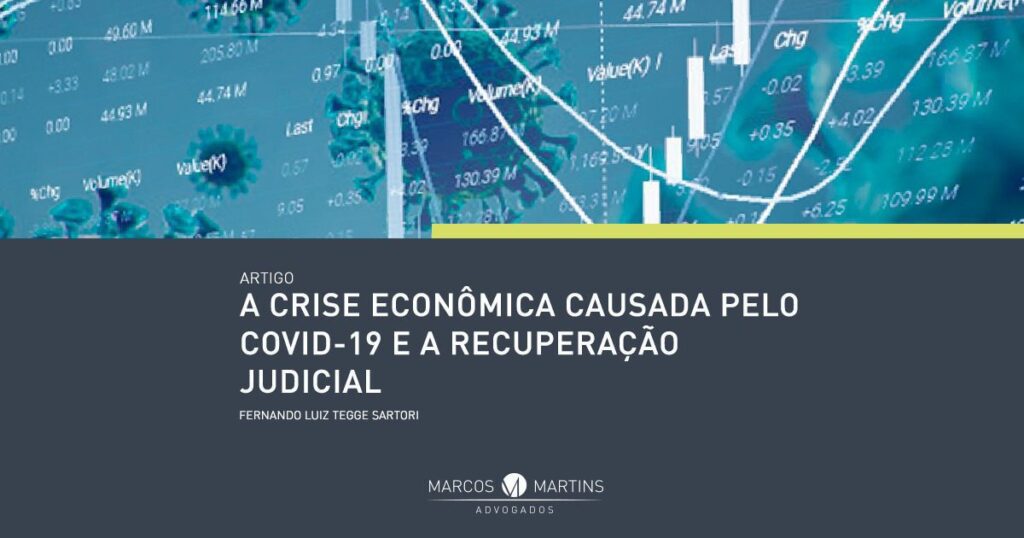Fernando Luiz Tegge Sartori
Lawyer at Marcos Martins Advogados
The economic crisis caused by the advent of COVID-19 has greatly altered the activities of many companies, whether in the way they serve their clients, negotiate new contracts or search for solutions to maintain their business activity.
This crisis has triggered, especially due to social isolation, a sharp slowdown in the consumption and production of goods and services, credit restrictions, even leading to unemployment, despite some incentives provided by the government, but which do not always meet the needs of entrepreneurs.
This is because companies’ turnover has fallen and will continue to fall as long as this exceptional pandemic situation persists, while the debts existing at the time when companies operated at their usual capacity remain and are demanded by their creditors.
As Cassio Cavali rightly points out [1]:
“there is a monumental mismatch between economic time and financial time, as summarized by Lawrence Summers on the Bloomberg website: ”economic time has stopped because of the pandemic, but the financial clock has kept ticking. Interest payments, rents and other obligations are still due, but the money to meet them has dried up.” The result of this mismatch is the business crisis of epic proportions that we are about to face.”
In order to find a solution to the economic crisis caused by the advent of COVID-19, there have been numerous debates about legal alternatives and legislative proposals to help the economy. Until the current legislation is changed, it is necessary to look for amicable solutions or legal measures to restructure the debt.
On this point, there has been an increase in lawsuits aimed at renegotiating contracts or renegotiating specific debts based on the theory of unpredictability, a request that must be analyzed on a case-by-case basis and which can solve specific problems for companies, with the aim of rebalancing contracts.
However, there are many cases of companies that have several creditors, with debts that would be easily supported in a regular economic situation, but which do not reach amicable solutions. In these cases, Judicial Recovery, regulated by Law 11.1011/2005, is a legal alternative to the crisis.
The Judicial Recovery procedure is an effective solution for companies that have been unsuccessful in out-of-court negotiations or in the administrative restructuring of the company, as long as they are able to meet the minimum requirements set out in articles 48[2] and 51[3] of Law 11.101/2005.
Judicial reorganization will give the debtor company a financial boost, under the terms of Article 6 of Law 11.101/2005[4], which guarantees the suspension of all executions filed by its creditors for a period of 180 days, as well as the possibility of collectively renegotiating its debt.
The payment proposal, offered in the Judicial Recovery Plan, is unique to creditors who are in the same situation, including labor creditors, creditors holding a guarantee in rem, unsecured creditors (common suppliers) and those considered to be micro-enterprises or small businesses.
Article 50[5] of the reorganization law sets out a non-exhaustive range of means of judicial reorganization, including the possibility of offering creditors special terms and conditions for payment of obligations due or falling due (debt installments, grace periods, discounts, punctuality premiums), sale of assets, among others.
If the judicial reorganization plan is approved, it will be valid and binding even on creditors who disapproved of the plan, but who were defeated by the will of the majority, under the terms of art. 58, §1 of the LRF[6] and therein lies one of the great benefits of collective bargaining, capable of resolving existing debts with creditors with a stricter negotiating stance.
There are countless cases of success in renegotiating debts and overcoming crises – largely due to the safe negotiating environment provided by the judicial reorganization process, including by companies that, if subjected to a cold analysis of their balance sheet or cash flow, would be considered technically bankrupt.
In any case, before opting for this judicial measure to restructure debt, it is of the utmost importance to carry out a study on the company’s debt profile, as well as a study on the company’s economic viability, so that it is possible to identify the best proposals for creditors, taking into account company and market projections in relation to debt.
Marcos Martins Advogados is always aware of the doctrinal and jurisprudential discussions on the subject and is available to its clients to find the best solution for their needs.
[rock-convert-pdf id=”14383″]
[1] Cavalli, Cássio. Should Brazil adopt new rules to deal with the economic crisis? Available at:<https://www.cassiocavalli.com.br/o-brasil-deve-ou-nao-adotar-novas-regras-para-enfrentar-a-crise-economica/>. Accessed on: May 4, 2020.
[2] Article 48. A debtor may apply for judicial reorganization if, at the time of the application, it has been carrying on its business regularly for more than two (2) years and meets the following requirements, cumulatively: I – they are not bankrupt and, if they are, the liabilities arising therefrom have been declared extinct by a final judgment; II – they have not been granted judicial reorganization for less than five (5) years; III – they have not been granted judicial reorganization for less than five (5) years on the basis of the special plan referred to in Section V of this Chapter; IV – they have not been convicted or do not have, as manager or controlling shareholder, a person convicted of any of the crimes provided for in this Law. § Paragraph 1 – Judicial reorganization may also be requested by the surviving spouse, heirs of the debtor, executor or remaining partner. § Paragraph 2. In the case of rural activity by a legal entity, proof of the deadline established in the main body of this article may be provided by means of the Corporate Economic and Tax Information Statement – DIPJ, which has been submitted on time.
[3] Art. 51: The initial petition for judicial reorganization shall be accompanied by: I – a statement of the specific causes of the debtor’s financial situation and the reasons for the economic and financial crisis; II – the accounting statements for the last three (3) fiscal years and those drawn up especially to support the petition, prepared in strict compliance with the applicable corporate legislation and compulsorily comprising: a) balance sheet; b) statement of accumulated results; c) statement of results since the last fiscal year; d) cash flow management report and its projection; III – a complete nominal list of creditors, including those for obligations to do or give, with an indication of the address of each one, the nature, classification and updated value of the credit, itemizing its origin, the regime of the respective maturities and an indication of the accounting records of each pending transaction; IV – a full list of employees, including their respective positions, salaries, indemnities and other payments to which they are entitled, with the corresponding month of accrual, and a breakdown of the amounts pending payment; V – the debtor’s certificate of good standing with the Public Registry of Companies, the updated articles of incorporation and the minutes appointing the current administrators; VI – a list of the private assets of the debtor’s controlling partners and administrators; VII – updated statements from the debtor’s bank accounts and any financial investments of any kind, including investment funds or stock exchanges, issued by the respective financial institutions; VIII – certificates from protest registries located in the district of the debtor’s domicile or head office and in those where it has a branch; IX – a list, signed by the debtor, of all legal actions in which it is a party, including those of a labor nature, with an estimate of the respective amounts demanded.
[4] Art. 6 The decree of bankruptcy or the granting of judicial reorganization suspends the running of the statute of limitations and all actions and executions against the debtor, including those of the private creditors of the joint partner.
[5] Art. 50. The following, among others, shall constitute means of judicial reorganization, with due regard for the legislation pertinent to each case: I – granting of special terms and conditions for payment of overdue or maturing obligations; II – spin-off, incorporation, merger or transformation of the company, creation of a wholly-owned subsidiary, or assignment of quotas or shares, with due regard for the rights of the partners, under the terms of the legislation in force;
III – alteration of corporate control; IV – total or partial replacement of the debtor’s administrators or modification of its administrative bodies; V – granting creditors the right to elect administrators separately and the power of veto in relation to the matters specified in the plan; VI – increase in share capital; VII – transfer or lease of premises, including to a company set up by the employees themselves; VIII – reduction in salaries, compensation for working hours and reduction in working hours, by means of a collective agreement or convention; IX – payment in kind or novation of debts under liabilities, with or without the constitution of their own guarantee or that of a third party; X – incorporation of a creditors’ company; XI – partial sale of assets; XII – equalization of financial charges relating to debts of any nature, with the initial term being the date of distribution of the petition for judicial reorganization, including rural credit agreements, without prejudice to the provisions of specific legislation; XIII – usufruct of the company; XIV – shared administration; XV – issue of securities; XVI – incorporation of a special purpose company to adjudicate the debtor’s assets in payment of the claims.
[6] Art. 58: Once the requirements of this Law have been met, the judge shall grant judicial reorganization to the debtor whose plan has not been objected to by a creditor under the terms of Art. 55 of this Law or has been approved by the general meeting of creditors under the terms of Art. 45 of this Law. §Paragraph 1. The judge may grant judicial reorganization based on a plan that has not been approved pursuant to Article 45 hereof, provided that, at the same meeting, it has cumulatively obtained: I – the favorable vote of creditors representing more than half the value of all claims present at the meeting, regardless of class; II – the approval of two (2) of the classes of creditors pursuant to Article 45 hereof. 45 hereof or, if there are only two (2) classes with voting creditors, the approval of at least one (1) of them; III – in the class that rejected it, the favorable vote of more than one-third (1/3) of the creditors, computed in accordance with §§ 1 and 2 of Article 45 hereof.








